
views
Using Olive Oil as a Cooking Tool
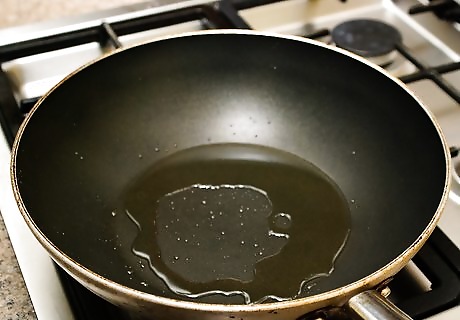
Heat in pan for sauteing. One of the most common uses for olive oil is as a saute oil. In this style of cooking, a small amount of oil is used to fry the food in a pan on the stove top. The oil keeps the food from sticking to the pan and adds a light sear along with some flavor. Try adding a tablespoon to a hot pan before tossing in your main ingredients in a stir fry or similar pan-cooked dish. Olive oil tends to have a fairly low smoke point (see "Tips" below). At high heats, it will smoke and gain a slightly bitter taste. For this reason, it's not usually a good choice for deep-frying (cooking by submerging in very hot oil).
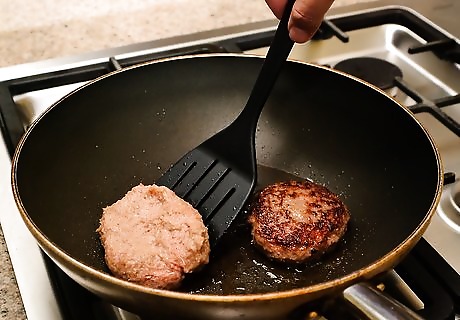
Paint pieces of meat to get a pleasing sear. Pieces of meat like steaks, pork chops, and chicken wings tend to taste best if they have a crisp, golden-brown exterior (in cooking, this is called a "sear"). A good way to get this is to paint both sides of the meat with a little olive oil before laying it on a hot surface. Flip the meat infrequently to allow the sear to form. Try tossing the meat in your favorite dry seasonings after you apply the olive oil. The seasonings will stick to the oil, giving you a finished product with a flavorful crust. In this role, olive oil isn't just for the stove. You can use it on the grill by painting it directly on the bars with a grill brush.
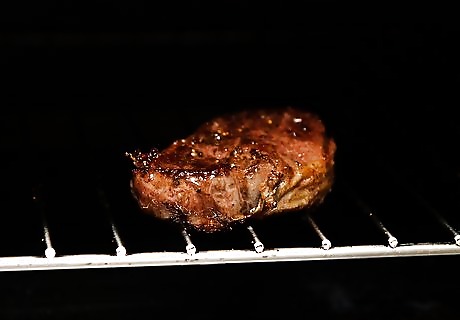
Coat roasting ingredients for a crispy exterior. Roasting is a style of cooking that uses dry heat from all directions to get meat or vegetables tender on the inside and crispy on the outside (think a Thanksgiving roast turkey). To get a tasty exterior similar to the sear you'd get in the step above, apply a thin coat of olive oil to the entire outside surface of the food you're roasting. Don't use too much — this can lead to a greasy, soaked exterior rather than a crisp crust. If you're roasting many small things as opposed to one large thing, just put the ingredients in a bowl, pour in a little olive oil, and shake to coat them. This is a good way to roast vegetables like green beans, chickpeas, broccoli, and more.
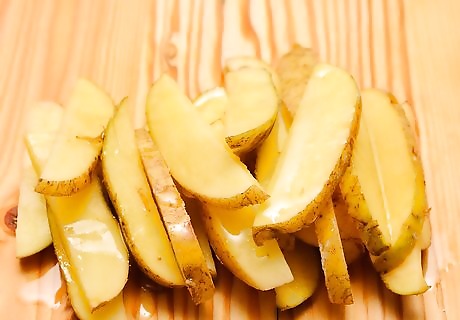
Use it to keep ingredients from sticking. Sometimes, olive oil is used as a sort of "lubricant" to keep pieces of food from sticking together. Its mild flavor and its slick texture exterior make it perfect for this. You don't typically need very much oil to get this effect. About a tablespoon should do for most dishes. Olive oil is most famous for being used this way to cook pasta. Adding a tablespoon of oil to the boiling water just before adding the pasta ensures that the noodles won't cling to each other in the strainer or on your plate.

Use it as a finishing oil. When olive oil is added to dishes at the very end of the cooking process, it is called a "finishing oil." In this case, it's usually being used to complement the food's flavor and texture or give it a pleasing presentation. Here, again, you don't need much. A teaspoon or two gently drizzled over the finished dish is usually plenty. This is another case where pasta is a common example. Lightly dressing a plate of pasta with a little oil can give it a smoother texture and a pleasing aroma along with a satisfying "heft" from the added calories.
Using Olive Oil as a Recipe Ingredient
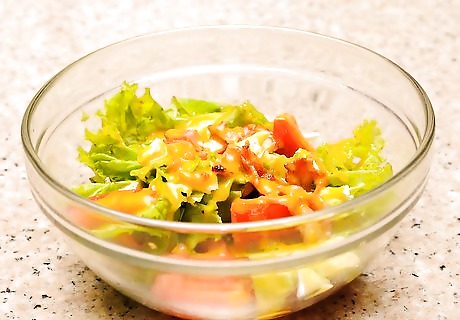
Toss in a salad with acidic ingredients for an easy dressing. Take advantage of olive oil's bright, pungent flavor by using it as the base for a salad dressing. Most dressings mix oil with acidic items such as tomatoes, citrus juices, or vinegar to "cut" the fatty-ness of the oil and give the dish a tangy quality. Tart ingredients in the salad itself also tend to pair well with olive oil. Try using it in the dressing for a salad containing slices of sour apples, strawberries or sharp cheeses for interesting flavor combinations.

Use as the oil base of a marinade. Marinades are mixes of ingredients that foods are soaked in before cooking for extra flavor. In this role, olive oil tends to complement foods with earthy flavors, such as meat, poultry, mushrooms, legumes, nuts, and whole grains. Olive oil marinades can also be enhanced by fresh herbs - thyme, savory, basil, tarragon, and dill work very well. Like salad dressings, most marinades also have an acidic ingredient in addition to the oil to keep it from tasting too greasy or heavy.
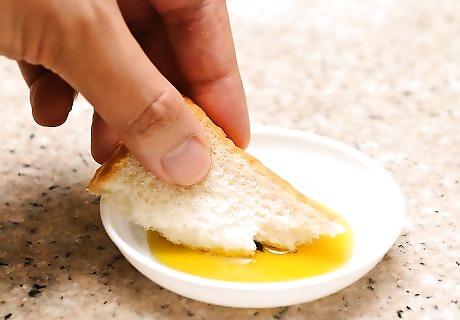
Use as a dipping sauce. Sometimes olive oil's smooth flavor is best enjoyed on its own. A small bowl of olive oil works great for dipping appetizers like bread, bruschetta, vegetables, and many more. Add acids or herbs like garlic, thyme, and sage to the oil to give it a more complex, interesting flavor. One common example of this is the mix of olive oil and balsamic vinegar that is often served with bread at Italian restaurants. The bread is used to soak of some of the oil mixture and carry it to your mouth for a satisfying (but not overly heavy) appetizer.

Use as a fatty base in savory baking recipes. Olive oil isn't an extremely common ingredient in baking — its flavor is more suited to meats and vegetables than it is to pastries and desserts. However, olive oil is great for adding an extra dimension to certain breads and rolls that are designed to have a savory flavor. Baking recipes that contain ingredients that traditionally go with olive oil (like this rosemary bread recipe) tend to be the best choices. If you're adventurous, you can even substitute olive oil for vegetable oil or canola oil in ordinary baking recipes to give them a new flavor. You may want to add a few more ingredients that go well with olive oil to complement the flavor. For example, try substituting olive oil for vegetable oil in your favorite pancake recipe. Mix a few minced cloves of garlic and some caramelized onions into the batter for a savory treat.

















Comments
0 comment